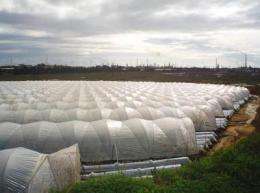Heavy metals and pesticides threaten a Huelva wetland

The Estero de Domingo Rubio wetland, located near the Marismas del Odiel Natural Area in the Huelva estuary, is regionally, nationally and internationally protected thanks to its ecological value. However, its tributary rivers and the Ría de Huelva estuary pump manmade pollutants into it, which could affect its water quality and ecosystem.
Industrial activity, accumulations of dangerous waste, the expansion of farming, and excessive extraction of sand and gravel for the construction industry are the leading threats to the Estero de Domingo Rubio wetland, the tidal system of which plays a "crucial" role in transporting and dispersing pollutants.
The wetland is "periodically flooded with high levels of dissolved elements such as copper (Cu), arsenic (As), cadmium (Cd), cobalt (Co), chrome (Cr), nickel (Ni) and zinc (Zn), which come from the water entering the estuary, which is affected by pollution from the mining industry", Cinta Barba-Brioso, co-author of the study and a researcher at the University of Seville (US), tells SINC.
The study, which has recently been published in the Marine Pollution Bulletin, shows that the wetland's tidal channel also receives acid lixiviates (liquid pollutants) that come from the dumping of sulphurous waste, industrial waste outflow pipes, and abandoned chemical plants, which all contribute to its metallic "enrichment".
Barba-Brioso says: "Agriculture is another significant source of diffuse contamination in the wetland" with nitrates and phosphates entering through agricultural runoff. "Domingo Rubio also receives inflows of phosphates from the Huelva estuary from the phosphogypsum stacks on the right hand banks of the Tinto river", the researcher explains.
Agriculture also generates pesticide concentrations in the water that "generally exceed the vulnerability levels set for wetlands by the European Commission (CCEE)", she stresses. "This contamination by agrochemicals could be prevented if there was greater control over the inflow of herbicides and fertilisers".
An altered ecosystem
Previous studies have used molecular biomarkers to document the biological consequences of pollution in the area and its effects on soils and plants in the wetland region.
To this must be added the alteration to local hydrodynamics, which has "a negative effect on the ecosystem, modifies the natural levels of heavy elements in it, and puts the wildlife communities that live in it at risk", points out Barba-Brioso.
The construction of roads has formed hydrological barriers in the upper parts of the Estero de Domingo Rubio, meaning the wetland now has two distinct hydrological and environmental areas – one marshland zone, with abundant halophile vegetation (characteristic of saline soils), and a lagoon zone – with aquatic and riverbank vegetation.
"Both of these zones are drained by a network of ephemeral tributaries, which are affected by intensively irrigated crops and industrial activities", the researcher says. The lagoon area and the streams in the river basin are "also affected by the lixiviates from this intensive agriculture, above all from the strawberry farming that is carried out in the area", the scientist explains.
However, the researchers say that hydrological restoration and environmental improvement work is currently being carried out in the area of the Estero lagoon by the Junta de Andalucía regional government and the European Union by means of the European Regional Development Fund.
More information: Barba-Brioso, C.; Fernández-Caliani, J.C.; Miras, A.; Cornejo, J.; Galán, E. "Multi-source water pollution in a highly anthropized wetland system associated with the estuary of Huelva (SW Spain)" Marine Pollution Bulletin 60(8): 1259-1269, agosto de 2010.
Provided by FECYT - Spanish Foundation for Science and Technology















